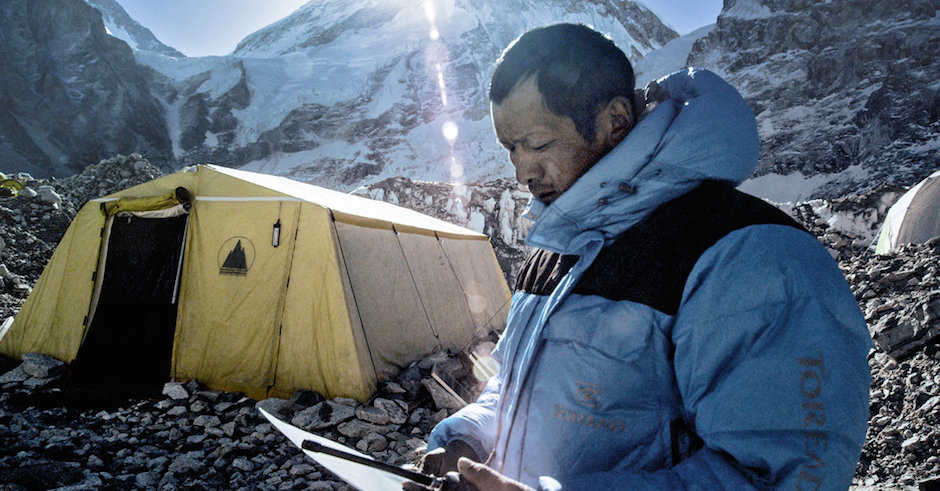 That time Prince did the soundtrack for Tim Burton's BatmanJust a small moment amongst thousands in the career of Prince.
That time Prince did the soundtrack for Tim Burton's BatmanJust a small moment amongst thousands in the career of Prince.

Cinepile Review: Sherpa is a beautifully poignant, cautionary tale
Tom Wolff was seriously impressed with the other movie made last year about Everest.
You’ll have to see Sherpa. It’s beautiful and poignant, at times frustrating and most definitely cautionary. Unsurprisingly given the title, the film centres around the Sherpa people of Nepal, an ethnic group who – rightly or wrongly – for the last 50-60 years have been seen more as porters for Western mountaineers than a race of people with their own belief systems and societal customs. Sherpa are deeply spiritual people, drawing on Buddhist divinities while also honouring their own form of deities for which they hold a profound respect.
The film Sherpa can be enjoyed for its cinematography alone. While it skilfully captures the awe inspiring beauty of Chomolungma (Mt Everest), Sherpa also explores the impending and inherent danger of a mountain that demands the utmost respect from anyone wishing to climb it. Most importantly, the filmmakers have depicted the humility and natural wisdom of a race of people who seem to have been forgotten as the Everest circus driven predominantly by well-off Westerners only continues to grow and proliferate. The Sherpa interviewed in this film are so honest and genuine I was left emotionally disarmed and on the verge of tears on multiple occasions during the film - something that doesn’t happen to me too often.
One of Sherpa’s protagonists is Phurba Tashi Sherpa. Phurba hails from Khumjung – a village that most clients of Everest expeditions pass through on their way to base camp. Following in his father’s footsteps, Phurba works on Chomolungma and jointly holds the world record for the most ascents. As Head Sherpa for Himalayan Experiences – he is employed by Kiwi owner and operator, Russell Brice, who also features in the film. In the basic kitchen of Phurba’s home, the anxiety is clearly delineated in the subtle lines of Karma Doma Sherpa. Karma is Phurba’s wife and she does not want him to climb this year. She tells us that he made a promise to her. Karma tells us, distraught and confused, that Phurba loves Chomolungma more than he loves his own family.
Phurba tells us his main motivation for climbing is to provide for his family. Working on Chomolungma pays much better than any other job in his region – due no doubt to the extreme danger involved. As well as his wife, Phurba’s parents aren’t too pleased about his occupation. They, like many Sherpa, believe that to climb Chomolungma is to disrespect the deities most sacred to the Sherpa people. Phurba’s constant internal tug-of-war between financial security, his own spirituality, his relationship with employer Brice and balancing the wishes and opinions of his group of Sherpa workers is gently drawn out over the course of the film.

What’s special about this film is that it’s a sort of case study for what we are seeing across the planet. While tourism has benefits for any country – the promises of economic security, the potential benefits it brings such as access to education – the downside is exacerbated when Indigenous minority groups are involved. In Nepal, the 2011 census estimated the Sherpa population at around 687,000 – 0.6 per cent of the approximate 27 million people that call Nepal home.
Ed Douglas, a mountaineering writer and journalist, tells us in Sherpa that up to one third of revenue from Everest expeditions goes to the Nepalese government. The problem here, Douglas suggests, is the lack of redistribution to the people that work hardest on Chomolungma – the vast majority of whom are ethnic Sherpas. It becomes evident that there are clear issues relating to wages, the amount of compensation paid to families of Sherpas who die on the mountain, and basic insurance for the Sherpa community.
And that’s just the financial side of things. Sherpa also presents the detrimental effects of a distinct lack of respect on the part of tourists. It’s worth noting here that the people behind Sherpa have not sought to victimise Western operators or clients. Many visitors to Chomolungma seem to develop a newfound and indisputable reverence for the mountain and its people after spending upwards of two months in its shadow (and potentially on its summit). However, although there are elements of respect shown by many climbers towards Sherpas and the mountain they are intending on climbing they essentially still disregard the most basic belief of the Sherpa people – that Chomolungma represents the head of a Sherpa/Buddhist deity and should not, in any circumstances, be climbed.
And this is where Sherpa draws strong parallels to current issues in Australia. This week when the Northern Territory Chief Minister Adam Giles suggested the Nguraritja and Anangu people of the area should reconsider their opposition to tourists climbing Uluru - a place that is to them a sacred site (see this article for a fantastic comedic flip of a seriously concerning issue). Western society’s urge to conquer at any cost is drawn into a clear conflict with the adrenaline charged physical challenge that comes with climbing an alpine peak or summit. I can relate to it. The feeling you get from reaching the top of a challenging climb is really rewarding. But when Indigenous people who understand and have a profound respect for natural phenomena for their significance in a broader philosophical sense ask you not to climb something, you’ve gotta wonder whether the personal fulfilment outweighs the disrespect you’re causing. I’ve climbed Wollumbin (Mt Warning) on the New South Wales North Coast multiple times – and until recently I didn’t realise its symbolic importance as a sacred place to the people of the Bundjalung nation. I’ve made a decision never to climb it again. I’m not telling anyone else not to climb, because it’s not my place – but isn’t it worth giving it some thought?
Alright, back to the film again. I like Sherpa because I feel as though it endeavours to provide a balanced perspective and gives voice to the main players in a bourgeoning “adventure” industry. Yeah sure, there’s always selectivity, bias and the influence of personal context – I studied enough International Relations to at least understand that basic idea – but this film presents a creative portrayal of a reality we don’t often see and then lets the audience decide. That might sound easy, but to make a documentary that avoids external factors such as politics to the extent possible, is a very fine and difficult art. I reckon Sherpa does this very, very well.
Head to the Sherpa Film WEBSITE for more info on screening times.
image via.
 That time Prince did the soundtrack for Tim Burton's BatmanJust a small moment amongst thousands in the career of Prince.
That time Prince did the soundtrack for Tim Burton's BatmanJust a small moment amongst thousands in the career of Prince.
 Con Reviews: His HoroscopeWas the meaning of life discovered, did his day reach its full potential?
Con Reviews: His HoroscopeWas the meaning of life discovered, did his day reach its full potential?